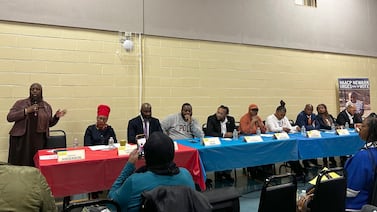A Colorado bill designed to make it easier for parents to find out how schools teach reading and spend funds earmarked for struggling readers has cleared another legislative hurdle and appears likely to become law.
The bill would require the state education department to publicly post certain pieces of reading-related information and, in turn, require schools to prominently display links to that information on their websites. On Thursday, a little over a month after the Senate approved the bill, the House Education Committee unanimously approved the legislation.
The transparency legislation comes out of an ongoing push by parents of students with dyslexia and other advocates to shine a light on the black box that is reading instruction at many Colorado schools. Currently, some districts make it hard for parents and the public to find out basic information about elementary reading curriculum, and to determine who’s using state-approved programs and who’s not.
Chalkbeat hit a variety of roadblocks over the last year when requesting lists of K-3 reading curriculums by school from several large districts. Leaders in Jeffco, Colorado’s second-largest district, at first said they didn’t know what reading programs their schools used because they had never collected that information before. It took months for the district to provide a list.
Other districts offered up lists full of holes. Officials in Douglas County, the state’s third-largest district, recently told Chalkbeat they had listed numerous schools as using “no published core program” because it was the only option under state education department rules.
A state education department leader subsequently told Chalkbeat the district was incorrect and could list any reading curriculum it wanted. District officials still haven’t responded to Chalkbeat’s follow-up request for a complete list of reading curriculum by school.
Parents have reported the same kind of obstacles in their efforts to find out which schools are using programs with solid track records of helping students with reading struggles. During the House Education Committee hearing on the bill Thursday, parents from the statewide dyslexia advocacy group COKID described spending countless hours wrangling with districts over reading curriculum requests, sometimes even being asked to pay for the information.
“In a local-control state we need parents to be well-informed because they play such a crucial part … in holding our districts accountable,” said Karin Johnson, a co-chair of the group.
Currently, districts submit copious amounts of information on reading curriculum, instruction and spending to the state. The problem is not much of that information is publicly available. The bill would change that by requiring the education department to post it in a “user-friendly format” and update it in a “timely manner.”
“Making this information easily discoverable is critical for use by parents of dyslexic and struggling readers,” said Laura Mitchell, a co-chair of COKID and a member of the Adams 12 school board, during the committee hearing. “Parents won’t have to rely on social media recommendations to find schools that serve their child.”
But big questions remain about whether the state’s public posting — which thousands of schools will be required to link to — will provide easy-to-understand information for the layperson.
Starting this spring, the state education department began posting school-level K-3 reading curriculum information on its website, but finding it is a tedious process, with wide variation in how the information is displayed and how different districts refer to the same curriculum. Also, information for many districts is missing.
In addition to these omissions and inconsistencies, there’s no indication of which curriculums are state approved or state-rejected. The transparency bill doesn’t require a curriculum’s approval status to be posted, so parents will continue to have to do that research on their own.
Over the last seven months, Chalkbeat has published searchable curriculum lists showing each program’s state approval status for Denver, Jeffco, Cherry Creek, and Aurora.
The transparency bill, in addition to making K-3 reading curriculum information more visible, will require the state to publicly post the number of K-3 students at each school who are on state-mandated plans for struggling readers and each district’s plan for spending funds dedicated to help those students. The state doesn’t currently post these items publicly and parents and taxpayers don’t have easy access unless they file public records requests.
Until last year, districts had wide latitude on how to spend those dollars — with some using the funding to buy discredited programs or items that don’t have anything to do with reading instruction, such as tote bags or lip balm.







